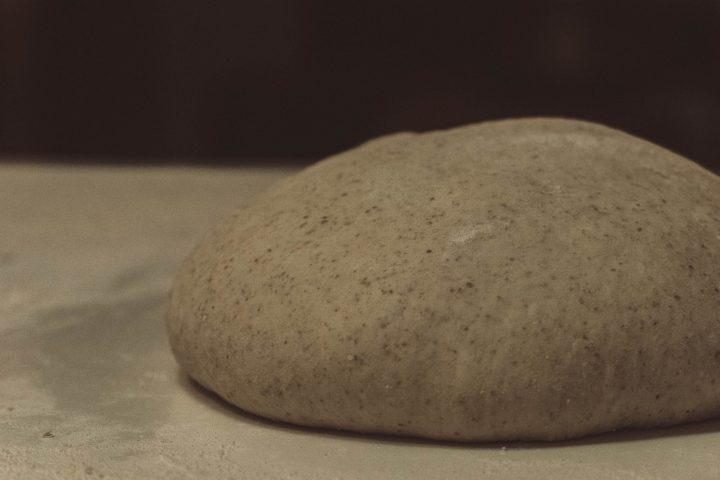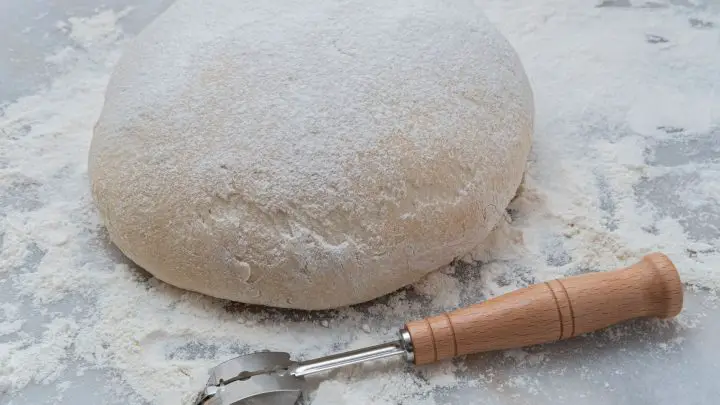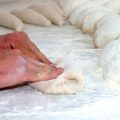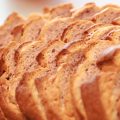There’s something comforting about the classic boule shaped loaves. If you’re a first time baker, then you’d probably stick to a sourdough boule shape for a while, until you get the hang of handling all sorts of sourdough, whether it’s high or low hydration. Stick around for the step-by-step guide!

Table of Contents
- What is a Boule?
- Boule Shaping Principles
- How to Shape Sourdough Boules
- Shape Sourdough Boule
- Boule Shape – FAQs
What is a Boule?
Like batard, Boule is a French term meaning bread in a round shape, and is one of the simplest bread shaping styles. It’s also one of the first shaping technique new bakers learn, simply because it requires a few motions to transform the dough into a shaggy, uniform round, that will bake beautifully in the oven.
The best type of bread to shape as boules are as follows:
- Loaves with a high whole grain percentage i.e., 100% whole wheat sourdough
- Porridge bread
- Loaves with other mix-ins
- Very large loaves
Boule Shaping Principles
It’s important to prevent your hands from sticking to the dough when shaping. Lightly dust your hands with flour to keep them from sticking too much.
The key to shaping a boule is to rely on the work surface to tug on the dough as you drag it across. If you use too much flour, the dough will slide easily, and won’t be able to develop sufficient surface tension.
The surface of the dough must not tear while shaping. If your dough does tear, it can be due to a very short dough rest, or the dough had been handled too roughly. If you notice your dough has begun to tear, then use a lighter hand to push, pull and fold the dough.

How to Shape Sourdough Boules
Once you’ve completed your stretches and folds, your bread dough must be shaped immediately.
- Lightly flour a clean work surface, then tip the sourdough bread dough onto it. Lightly flour the dough, then gently press it into a rectangle.
- Roll the dough towards yourself, creating a rough spiral, then press down lightly upon each roll, to ensure the dough is sticking to itself. You should now have a log-shaped dough.
- Turn the log so that the shorter end faces you. Flatten the dough slightly. Brush fragments of flour off your working surface. Flip the rolled dough over onto the dusted surface, spiral ends facing down.
- Sprinkle a light dusting of flour over the top of the dough, then use your hands to rotate the dough. Use your fingers to turn the dough clockwise. If this doesn’t work for you, then instead you can gently cup the dough at the base, and pull it toward you.
- The dough should be ready, once it holds its shape without spreading, as well as visible bubbles appearing under the surface.
- Gently lift the dough with your hands, or a bench scraper then places it seam-side up into a floured proofing basket.
Tips and Tricks
While you won’t necessarily require any tools for shaping your dough, you might find some useful. For instance, a dough scraper or bench knife can help rotate the dough, especially if you’re working with high hydration doughs, as they tend to stick to your hands. You can also use the dough scraper to lift the shaped loaf into the banneton.
A banneton is used to proof the shaped loaf. However, a bowl lined with a tea towel will provide the same outcome. Lames, or razor blades are great to use when scoring the dough.
You may find that some breads such as whole grain or gluten free kinds will be much trickier to shape, to which you should attempt to incorporate some bread flour.
If your dough tears while shaping, you may have to start again depending on how big the tear is. If you’re struggling to shape your dough, then you might want to opt for cold dough. Colder doughs are easier to shape for beginners, as well as lower hydration sourdough recipes.
Shape Sourdough Boule
The best way to create tension is through shaping and pre-shaping your dough. Ensure you pre-shaped dough is well rested before proceeding with the next steps. You can easily bake your boule shaped loaves in a Dutch oven for that perfect crisp, sourdough loaf.
Boule Shape – FAQs
What is Boule Dough?
A boule is bread dough shaped into a round. It is a traditional shape of French bread, resembling a squashed ball.
Where Did Boule Bread Originate?
Boule bread originated in France mainly due to the French ball game (jeu de boules). It is thought to have originated in 1910.
How Long Does Sourdough Boule Last?
Much like many sourdough breads, sourdough boule will remain fresh for four to five days at room temperature.






